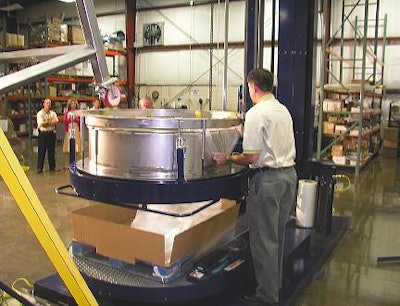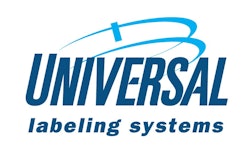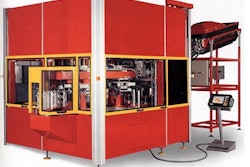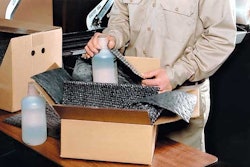
Consisting of a corrugated bottom sheet, a pre-made flexible-film bag, and stretch film, the K-one system replaces a corrugated bulk box and flexible film liner. Like that packaging format, the K-one bulk pack is used by Kellogg to move cereal from where it’s processed to where it’s packaged, whether in-house or at a contract packager.
Material cost savings aside, labor savings are gained because operators in the plant no longer have to set up corrugated bulk boxes. Meanwhile, at the receiving end, there’s no longer any need to break boxes down and dispose of them. Moreover, transportation costs are reduced because more product and less packaging can be loaded onto every truck.
As if all these benefits weren’t attractive enough, the new approach to bulk packaging creates a consistent containment force that locks product in place to reduce settling and damage during shipping.
Though the K-one system is built by Lantech, it is being marketed by Lantech and Kellogg together as Kellogg owns the patents related to the K-one system. That’s because the idea for the system originated in the minds of Kellogg engineers Dave Ours and Randy Cary. K-one is protected by one U.S. patent, and additional U.S. and foreign patents are pending.
“How do we move cereal in a bulk format and save money doing it while ensuring that the cereal will be at least as well protected against damage as it was under the bulk box approach?” says Ours. “That’s the question we were asking ourselves back when this all got started.”
Familiar as Kellogg was with bulk packaging machines and the companies that make them, Ours and Cary knew that the system they envisioned was not going to be an off-the-shelf item. They also had a hunch that if the equipment they had in mind could in fact be built, it would be suitable for a number of applications outside of cereal packaging. That’s when Dwight McCardwell, Kellogg’s director of corporate development, entered the K-one arena.
“When senior management agreed that this technology could be successfully applied outside of Kellogg’s plants, it became my group’s job to work closely with the engineers who originally dreamed it up to put together a strategy to commercialize it by coming up with a licensing plan,” says McCardwell. “Keep in mind that Kellogg Company licenses its brands all the time. But what made this a first is that we’re not talking about a consumer-oriented proposition, but rather a proposition revolving around industrial marketing. That’s quite different than licensing a brand.”
No walk in the park
McCardwell, Ours, and Cary all agree that pushing the K-one idea from concept state to commercially available product line was no walk in the park.
“At every step of the way, Dave and Randy met with considerable resistance,” says McCardwell. “There was always someone to remind them that you can’t put a thousand pounds of fragile material in a plastic bag and ship it around the country. But as a group we kept at it and proved it would work.”
Material cost savings was the key target from the beginning. That K-one would provide protection even better than the corrugated box it replaces “was something we discovered as we got into it,” says Ours.
How it operates
So just how does K-one operate? Packaging World had a chance to learn this past summer during a visit to Technical Packaging Systems, Inc., a Michigan machinery rep that handles Lantech equipment. The photos shown here help considerably in understanding how the machine works.
In sequence, an operator puts a corrugated base sheet on the pallet that sits on K-one’s load-cell platform. The operator then pulls a large, pre-made, flat-bottom bag from a perforated roll and attaches it to clips so that it hangs from a round collar. By pressing an icon at the touchscreen control panel, the operator causes the collar to ascend 10’. Product is gravity fed into the bag, which is pre-opened with a burst of air.
For a short time the stretch film carriage remains stationary as the bottom of the bag is filled. But as soon as product inside the bag mounts high enough, its level is detected by a photo cell that causes the film carriage to begin its ascent up the load. Sensors arrayed above this first one continue to detect product level height and continually signal the system’s main PLC to wrap at the speed required.
When the load cell beneath the pallet detects a predetermined weight, the flow of product is shut off. A bar then folds the bag top over the filled bag and wrapping resumes to pin the bag top down tight against the side of the load and create a seal that’s practically hermetic. The entire process takes about 3 min.
The importance of bulk packaging
Kellogg’s Randy Scherer, senior director of packaging technology & engineering, explains why an efficient bulk packaging system is so important.
“Most cereal we manufacture goes directly to the packaging line, but for some products we move from one location to another for finishing. We also send a lot of product to other firms for re-packing or contract packaging, a trend that has picked up steam lately as the club stores and other specialty-channel retailers have continued to grow. These retailers have different ideas about what a primary package should look like, so increased flexibility in packaging formats has become a constant challenge for us. That increases the usefulness of taking product outside, so any improvement in how we do that is sure to be helpful.”
According to McCardwell, the development of the K-one is partly a response to a fundamental shift in the whole business of cereal making and marketing. “We’re in the middle of a transition in our business where the standard consumer packs aren’t so standard anymore,” says McCardwell. “That puts a premium on being able to separate packaging from manufacturing in a cost-effective way, simply because the line that puts product into the unit pack—whatever that unit pack may be—may or may not be in the same location where the product is manufactured. K-one gives us an efficient way of getting product to wherever the desired unit pack operation is located, whether it’s in one of our own plants or at a contract packager.”
Scherer puts it this way: “It’s moving the food to existing packaging assets as opposed to adding packaging assets where the food is made.”
Cereal is not the only food category where K-one technology could prove useful. Pasta is another possibility, at least where short goods are concerned. Says McCardwell, “We wouldn’t license it to a competitor for use in cereal manufacturing, but we would license it to them for noncompeting products in their portfolio.”
Producers of resin pellets have also been targeted. “While a 500-lb cereal load is typically 100 inches tall, a denser and heavier product like resin pellets would require a shorter bag,” says engineer and K-one inventor Cary. “The bulk packs of resin pellets we’ve run have been in the 2ꯠ-lb range, and they measure about 72 inches tall.”
Film specs will vary by product, too. The pre-made bag used by Kellogg internally is made from a 3.5-mil blend of low- and high-density polyethylene. Applied around the bag as it’s filled is a 100-ga linear low-density PE stretch wrap.
“You want a pretty stiff film because you’re trying to apply as much hoop force as possible to keep that sphere of product from moving or shifting in the distribution environment,” says Ours.
Now that the K-one system is widely established in Kellogg’s own operations, says McCardwell, it’s time to push the idea as something others would buy. No wonder the equipment will be highlighted at Lantech’s Pack Expo both this November 7 to 11 in Chicago.


























